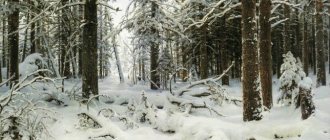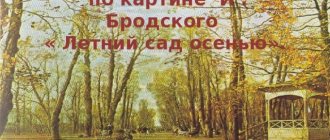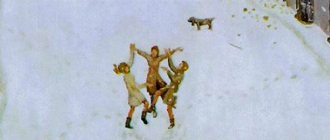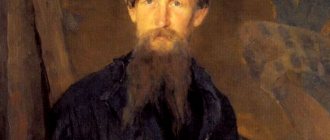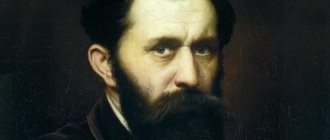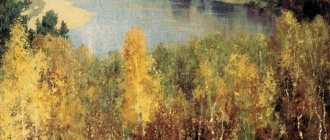- Essays
- According to paintings
- Shishkin
/
/
The painting, painted by one of the great artists of Russia, amazes with its naturalness, even slightly frightening reality. Yes, and the very name of this work of art, “In the Wild North,” gives away the whole meaning inherent in it.
This picture was painted by the outstanding landscape artist Ivan Ivanovich Shishkin in 1890. It was not painted from life, but was created precisely by the artist himself, his imagination, his talent. The reason for writing was an order from the St. Petersburg publisher P.P. Konchalovsky. The publisher asked famous artists of that time: Shishkin, Vrubel, Polenov, Vasnetsov, Serov to illustrate the collected works of M.Yu. Lermontov, which was published on the 50th anniversary of the poet’s death. Shishkin chose the poem “In the Wild North.”
Perhaps the artist’s choice fell on this work due to the theme of loneliness that was familiar to his heart and soul. Fate dealt him hard. Both of his wives died suddenly, 3 children died in infancy, his only, already adult daughter, lived far away, in another country. He was completely alone.
This is how the “main character” is represented in the picture - the pine tree. She stands alone in this snowy captivity, subject only to the elements and bad weather - all the trials that may befall her.
The picture is painted so realistically that it gives the impression that it is a photograph. All the details are spelled out so naturally here. Every stroke has its own meaning.
A poor, lonely pine tree stands on a high hill, illuminated by the light of the moon. Its wide branches-paws are sagging from the heavy sticky snow that has piled up and envelops them. She no longer has the strength to get rid of his shackles, which bound her and do not allow her to move. She humbly endures and bears her burden.
The moon, as if trying to help, extracting a large amount of light from itself, wants to warm the tree. But the light of the moon is distant and cold, no matter how much it is. It cannot give warmth, but only emphasizes hopelessness.
Rare fluffy clouds float across the sky, like light smoke. They don’t care about the pine tree, they walk past without paying attention to it. In the distance, there is an endless snowy “sea”, on which not a single silhouette of someone alive is visible, not a sound is heard. Pine is forced to “live” in this wild region, only in complete solitude.
The colors and shades with which this work was done are only cold, from snow-white to lilac-black, conveying cold, frost and doom in the best possible way.
This painting is truly an outstanding work of art. Only a person endowed with the greatest talent could create such a masterpiece of painting. This great man was Ivan Ivanovich Shishkin, who gave us the opportunity to enjoy his works and receive enormous pleasure.
Review of the painting
This picture seems mysterious to me and, of course, very beautiful. As I learned, the author was inspired by Lermontov’s poem. Shishkin practically drew an illustration for his short poem, in which in the wild north such a tree stands alone on a cliff... It seems to imagine that on the same cliff, but under the hot sun, there is a palm tree - its other half. Shishkin, however, did not paint the second picture (with a palm tree).
And yet, this pine tree reflects the lines of the poet. Indeed, the tree is lonely. It looks like a man standing sadly on a cliff, looking into the distance. The shoulders are slumped, the clothes are very heavy - there is so much snow on the branches. This also shows us the weather - cold, snowy... There has been no warming here for a long time. It keeps snowing... By the way, the pine tree looks like the silhouette of a woman in a fluffy dress. Yes, it’s normal for women to wait and be sad, in principle.
It’s interesting that there are horizontal lines in the clouds and cliffs, only the pine tree creates its own vertical.
The colors chosen here are very beautiful. It is clear that they are cold: white, blue, blue... But the artist manages to create such subtle and natural shades that the painting even makes you feel cool.
Behind the light hill there is a dark distance - almost black. The sky is lighter and has white clouds. A dark shadow falls from a pine tree. Although the moon is not drawn here, we can practically see it. According to this shadow, according to the cold lighting that comes from the right corner of the picture. I think this is the right approach. Why was it necessary to draw the moon if it is already clear that it is there? And she would also attract attention and distract from the main “heroine”.
It is possible that this cliff is the highest, because the others that we see are definitely lower. For some reason there are no stars in the sky either.
Naturally, I have a feeling of sadness, but a romantic one. The poem speaks, as I understand it, about love, about loneliness. This feeling of striving for the unknown, for the new, is felt.
Very beautiful landscape, beautiful “story”. A true artist, through a simple image of nature (and here it’s just snow all around), was able to convey a whole story, feelings, dreams. Wonderful picture! I would love to see it in the original...
Other topics: ← Winter in the forest. Frost↑ ShishkinPines illuminated by the sun →
`
Description of Shishkin’s painting “In the Wild North”
In the boundless northern darkness, among snow and ice, a snow-covered pine tree rises on a frost-bound cliff. It gives the impression of a powerful tree, wisely weathering the harsh cold and confident in the future warmth and affection from nature. The lush branches of the tree are wrapped in snow and obediently lowered down. But this pliability does not detract from the greatness of the giant - its trunk is stubborn, its roots are tenacious, which makes the tree seem eternal.
And all around there is blue-blue silence and an icy abyss. The blackness of infinity and the unknown in the distance in the lower part of the picture, the same immensity in the mysterious skies, a snow-covered cliff with a frightening frost-covered cliff in the gorge.
A bright moon can be seen above the snowy expanses, the pale and dispassionate light of which adds mystery and awe. It brightly illuminates a lonely tree, highlighting its soft contours, indicating thick shadow and emphasizing the royalty of the mighty giant. The night moonlight also falls on rare ragged clouds, quietly floating in the heights and looking like snowy paws from the branches of a frozen tree.
Popular writings
- Essay on the topic Chatsky and the Famus Society (9th grade)
The author of the satirical comedy play “Woe from Wit” examines the problems of interaction between two generations, the differences in beliefs, principles and views of their representatives. The Famus Society is the embodiment of the secular society of Moscow - Works based on Popkov's paintings
Description of Popkov's paintings - Essay on the painting The First Snow by Popov in the first person, grade 7
Today is an ordinary winter morning, as always, I got up very early and went to the window to find out if the long-awaited snow had fallen. Usually I saw a gray and dull yard through the window
Essay based on I. Shishkin’s painting “In the Wild North...” - for high school students
Heinrich Heine's original poem is included in the youth cycle "Lyrical Intermezzo" as part of the collection of his works created over 20 years, "The Book of Songs". The leitmotif of the cycle is the theme of love. Nature itself and the whole world become involved in the poet’s longing for his beloved.
Lermontov's poem has a broader meaning. His main idea is the loneliness and defenselessness of a person in the face of tragedies, the frailty of existence, and not just suffering, the cause of which was unrequited love.
Shishkin's painting unites the feelings of both poets, but only in its own way - through the master's brilliant painting. High school students, almost adults, are able to feel and be imbued with both the lines of the great poet and the richest color, as well as the deepest philosophical content of Shishkin’s painting.
"In the Wild North"
A wonderful artist - Ivan Shishkin. “In the Wild North” is a painting painted to illustrate the poem of the same name by Mikhail Yuryevich Lermontov, which, in turn, is a free translation of the poem “Pine” by the German poet Heinrich Heine.
Combining the motifs of Heine’s personal loneliness and the more generalized theme of the separation of human souls in Lermontov’s version, the painting “In the Wild North” creates a feeling of eternity in solitude, a timeless, but not hopeless state of sadness, which is ideal for both illustrating the original poem and its translation.
Almost any description of Shishkin’s paintings mentions the incredible realism and sensuality of his landscapes, the absolute certainty that this place exists somewhere, and if you get there, it will look exactly as Shishkin transferred it to the canvas. “In the Wild North” is a picture that is no exception to this rule.
Essay based on Shishkin’s painting “In the Wild North...”
Option 1
The painting by the great Russian landscape painter Ivan Shishkin, of the same name as the famous poem by Mikhail Lermontov “In the Wild North...”, was written based on his motives.
The artist began to implement his plan in 1890, when a group of entrepreneurs and artists worked on the publication of an anniversary collection of Lermontov’s works. The publication of the book coincided with the 50th anniversary of the death of the great Russian poet.
Shishkin chose this short poem by Lermontov, a free translation of Heine, at the behest of his feelings. The theme of loneliness was close and understandable to the artist. There were many tragedies in his life. And now, in old age, he was alone again.
Having caught the sincere pain of loneliness in Lermontov’s lines, the artist felt a kindred spirit in the main character, the pine tree. His own vision allowed the painter to create a truly great work, after looking at which you begin to feel the tingling of the frosty air, the mysterious silence, and the unprecedented scope of the endless north.
A lonely pine tree on the edge of the gorge is brightly illuminated by moonlight. To some extent, he acts as an assistant to the artist - thanks to him, shadows, rocks, tree branches, and clouds appear in such relief and contrast. Only the blue-black distance remains unknown.
The orphanhood of a pine tree is consonant with the loneliness that happens in people’s lives. But the tree doesn’t just stand there, it lives here, in this harsh region. At the same time, it is tall, fluffy, and beautiful. This means you can wait out the cold and adversity, wait for your spring. You just need to call on all your courage and try not to lose interest and will to live. There will definitely be warmth and joy.
This painting is a true masterpiece of the brilliant artist Ivan Ivanovich Shishkin. A deep, colorful, realistic and bewitching work that makes you not only admire the undeniable beauties, but also think and philosophize.
Essay on the theme of the wild north based on a painting
Ivan Ivanovich Shishkin is a wonderful Russian painter, the greatest master of realistic landscape painting. By creating beautiful images of his native nature, Shishkin played an important role in strengthening the folk character of Russian culture. All of Ivan Ivanovich’s works are worthy of attention, since they glorify the beauty of his native nature. One of these paintings is the heartfelt painting “In the Wild North.” The painting was painted by Shishkin in 1891 and is now kept in the Kiev Museum of Russian Art. The painting “In the Wild North” is based on Mikhail Yuryevich Lermontov’s poem “Pine” (1841): In the wild north, a pine tree stands alone on a bare top. And she dozes, swaying, and she is dressed in loose snow like a robe. And she dreams of everything that in the distant desert, In the land where the sun rises, Alone and sad on a flammable cliff A beautiful palm tree grows. This heartfelt poem was chosen by the artist to illustrate a collection of the poet’s works. The collection was dedicated to the anniversary - the 50th anniversary of the tragic death of Mikhail Yuryevich. This collection of works was ordered by the St. Petersburg publisher Pyotr Petrovich Konchalovsky, one of the owners of the book publishing house of I. N. Kushnerev. The published collection of works contained many colorful illustrations by famous artists: V. A. Serov, M. A. Vrubel, V. D. Polenov, as well as I. I. Shishkin. It should be noted that the lyrical creation of Mikhail Yuryevich Lermontov “Pine” is a free translation of a poem by the German poet Heinrich Heine. Lermontov translated this poem literally in the blink of an eye at the request of Prince Vyazemsky. Heine wrote his poem “The Pine” in 1822. This work is the final one in the youth cycle of poems “Lyrical Intermezzo”. The cycle of poems was part of the “Book of Songs”, which was created by Heinrich Heine over the course of twenty years. The leading motive of the written cycle of poems was a romantic theme. When a hero in love is yearning for love, it seems that even nature itself is involved in his love. Therefore, in Heine’s lyrical work, the hero’s unrequited love is compared to the longing and longing of a pine tree dreaming of a beautiful palm tree. The difference between Lermontov’s poem and Heine’s work is that our Russian “Pine” is more figurative and heartfelt. Lermontov's poem touches not only romantic chords. Mikhail Yuryevich managed to show the theme of melancholy loneliness, the theme of the mortal existence of man, the tragedy of misunderstanding between people. Ivan Ivanovich created two drawings for Lermontov’s poems - “Pine” and “Motherland”. While working on the drawing “Pine”, Shishkin thought about creating a winter oil painting “In the Wild North”. In order to realistically and believably convey all the features and colors of winter, Shishkin began to go to Mary Hovi, to his daughter’s manor, and observe the snow and winter landscapes. It was there that Shishkin painted his wonderful, crackling winter canvases: “Frosty Day”, “In the Wild North”, “Towards Evening”. Shishkin’s painting “In the Wild North”, as well as Lermontov’s poem “Pine”, just oozes a heart-aching feeling of loneliness and abandonment. A single pine tree grows on a bare rock. She forlornly bowed her branches under the weight of snow and ice, she is surrounded by hopeless darkness and indifferent cold. However, neither bitter frost, nor piercing wind, nor heavy snow, nothing can break the mighty tree. This is a heroic tree that will not bend or tremble. In his poem, Lermontov compares the blanket of snow covering the pine tree with a priest’s robe. Shishkin realistically embodies this comparison on his canvas. Indeed, the sparkling and iridescent snow in the picture resembles the vestments of clergy woven in silver. The lighting is written very meticulously on the canvas. The moon illuminates a rocky gorge, illuminating a mighty pine tree with its light. Due to this lighting, the left side of the pine tree is drowned in darkness, but the right side is brightly lit, its outline is clearly visible. There is no pure white snow, and on his canvas Shishkin uses a variety of shades of white with the highest skill: gloomy grayish, cold bluish, piercing white. It is interesting to note that on the top of the pine tree the snow is very reminiscent of clumps of clouds that float across the sky. This creates the illusion of a conversation between the snow and clouds. There is silence all around, the pine tree is dozing and dreaming of another bright, beautiful world. It is worth noting that in style, Shishkin’s painting is reminiscent of the romantic paintings of another landscape artist, Arkhip Ivanovich Kuindzhi. The artists got along well and were friends with each other. The color scheme used in the painting is very contrasting: heavy, gloomy shades of dark blue in the abyss and piercingly bright shades of blue snow in the light. When the work on the painting was completed, and the Belarusian painter Vitold Kaetanovich Byalynitsky-Birulya saw it, he said the following: “Remember M. Yu. Lermontov’s “In the Wild North” - a moonlit night, a pine tree dressed like a robe. I am convinced that if Lermontov saw Shishkin’s painting, he would be happy.”
Description of the painting In the Wild North for 9th grade
Loneliness... What could be more ominous and frightening? Realize that you are completely alone, without protection and support. This is unbearably painful for all living things.
Poets, composers, and artists often touch on the topic of loneliness in their works. I would like to note the well-known work of the great landscape painter Ivan Ivanovich Shishkin “In the Wild North.” Looking at the masterpiece, you involuntarily feel a feeling of sadness. In a remote and deserted area, on the very edge of a high mountain, a mighty pine tree stands, doomed to loneliness. Around her there are only vast snow-covered expanses and chilling silence. Time has stopped here. It’s as if all living things have forgotten the way here: neither a bird will fly, nor an animal will pass.
Why was she destined to be born here surrounded by the harsh northern winter? After all, in her dreams she is far, far away from here, in a life full of joy and peace. Under the cover of the deep night, a pine tree stands, sadly turning its gaze to the sky, to the clouds passing by, to the moon shining so clearly. And it illuminates with a fabulous radiance, filling everything around with incredible beauty and wealth.
But the pine tree stands. Despite the merciless frosts, swaying from the cruel and cold wind, she continues to live. Its branches bend under the weight of snow, but it still grows. A proud and resilient tree will continue to overcome all obstacles against fate, showing its immense desire to live. Nothing can break a pine tree; it will not submit to difficulties and adversity!
Without a doubt, the author succeeded in conveying to us the main idea and mood of the picture. Fight no matter what, defend your right to exist in this huge world, even alone. Yes, it is difficult, sometimes unbearable. But let the struggle for the life of a forgotten living creature, a pine tree, unbroken and undefeated, be an example for everyone.
Interesting essays on paintings
- An essay based on the painting News from the Front by Vatolina, 8th grade
Nina Nikolaevna Vatolina became very famous thanks to her work and patience in 1943. It was in this year that the painting News from the Front was painted. In her painting she conveyed a flurry of emotions - Essay based on the painting by Gerasimov After the rain (wet terrace) 6th grade description
We see an image of a terrace after the rain. This natural phenomenon itself can be interpreted in two ways. - An essay based on the painting by Pieter Bruegel the Younger Winter Landscape
Pieter Bruegel the Younger began his work in his early years. As a child, he often copied his father's finished works. Later, having developed his skills, he developed his own unique creative style - Essay on the painting Blue Spring by Baksheeva 2nd, 3rd grade
A beautiful painting with a beautiful name. Why is spring blue and not green? This is the color of green. Typically, spring is always associated with young greenery. I think it’s just that greenery doesn’t appear right away. But the sky is so blue only in spring. - Essay based on the painting by Bogdanov-Belsky Virtuoso (description)
In front of me is an amazing painting by N.P. Bogdanov-Belsky "Virtuoso". This painting shows five children, four little boys and one girl.
